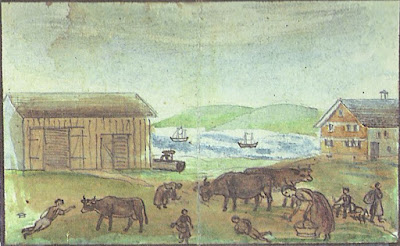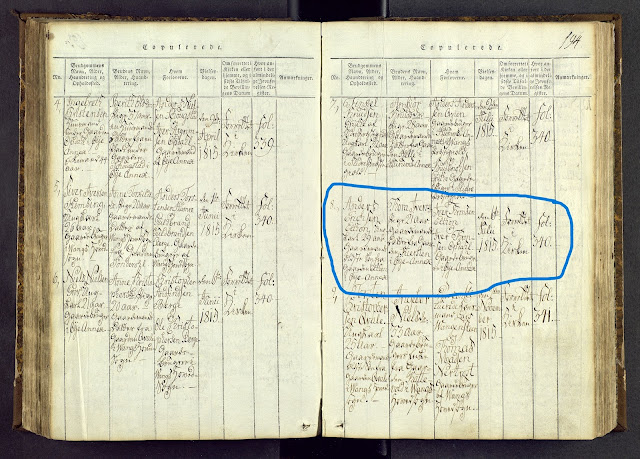1816: The Year Without a Summer (52 Ancestors 2022 week 21, variation on the Theme: "Yearbook")
Spring 2022 has been unusually cold and wet where I live on Canada's west coast. As records here have been broken, it has come to my attention that there was another year with worse and more widespread broken records. The year 1816 is often referred to as "the year without a summer" or as "Eighteen-hundred-and-froze-to-death".
Snow storms blanketed the ground in Europe and North America in May that year. A huge storm in early June covered Eastern Canada and Northeastern United States from Maine and upstate New York to Pennsylvania with up to 30 cm of snow. The cold weather continued with frost occurring every month of the year in many places. The sky was dark and had a strange reddish cast. Some of the snow that fell was brown or red.
Crops froze and were replanted only to freeze again. Yields were terrible, just when the world had been hoping for an abundant harvest to recover from the Napoleonic Wars. (1816 was the year when Napoleon was finally defeated and sent into exile on Saint Helena. It has even been suggested that Britain's victory in the Battle of Waterloo that year could be at least partially attributed to the wet and muddy conditions.)
Summer temperatures in Europe were the coldest on record for the period 1766-2000. Switzerland, for example, reported summer temperatures that year between 2.5-3 degrees C. cooler than the norm. Lord Byron, Percy Bysshe Shelley and Mary Godwin (who later became Mary Shelley) spent the summer near Geneva, Switzerland. The cool weather and endless rains reportedly kept them indoors writing, resulting in the creation of Mary Shelley's "Frankenstein".
Other artistic creations from 1816 include Lord Byron's "Darkness", Jane Austen's "Emma" and Rossini's "Barber of Saville".
Although the actual temperature of the planet dropped less than 1 degree C., the effects were widespread and catastrophic. Crop failures led to famine resulting in the deaths of an estimated 100,000 people. It was the worst famine in mainland Europe for the entire 19th century. Major typhus epidemics occurred in Europe in the years immediately following, running rampant through a population weakened by malnourishment. As one might expect, political and economic consequences were profound. Despair prevailed.
 |
| Hunger in der Schweiz 1817 |
At the time, there was no good scientific explanation for why this had happened but many theories were put forward. It is now generally accepted that a major cause was volcanic ash sent into the atmosphere by the explosion of Mount Tambora on the island of Sumbawa in the Dutch East Indies (now Indonesia) in April of 1815. This explosion was the greatest in at least 1300 years. Serious local repercussions ensued and thousands died in the immediate aftermath. The following year had bad weather in Asia, much as in Europe and America, with China reporting severe floods and famine.
We all would have had family affected by this event. At the time, many of mine were in Norway and the Northeastern United States (mostly in New York and Pennsylvania). We don't have any stories or diaries from my family members to let us know specifically how they fared, but the general conditions in the areas would have been their experiences. As there were dozens of family members alive in 1816, I will select just a few to highlight.
New York
 |
| Upstate New York - Family Locations inn 1816 (Google Earth image) |
 |
| 1820 U.S. Census for Paris, Oneida County, New York - John Bullen family |
A few years later, David would marry Jane Murdie (1801-1857), my maternal line ancestor whose mitochondrial DNA has come down to me and my family. Notionally, my mitochondrial DNA spent the year without a summer in the safekeeping of Jane in Hannibal, Oswego, New York.
A bit of a mystery surrounds Jane's family but my best guess at present is that her mother was most likely Jane Davidson (or Davididson) whose Murdie first husband had gone missing and was presumed dead sometime around 1815. The mother then remarried in about 1816 to a man named John Chambers and had three more daughters with him. By the time of the 1820 census for Hannibal, we might conclude that the 5 people listed were John and his wife Jane Davidson Chambers, their own two infant daughters under age 10 (Kate and Louisa Chambers) and Jane Murdie for the female aged between 16 and 25.
1820 census for Hannibal, Oswego, New York - Murdie/Chambers householdWe don't know exactly what impact the year without a summer had on Jane Murdie who was a young woman at the time, but she would not have been enjoying wearing lighter summer attire that year. It was said that everyone bundled up in their greatcoats all through the summer.
Other branches of my mother's family were living in the area of Butler, Wayne County, New York in 1816. My 3rd great grandparents Stephen Wescott and Catherine Barton were both children living with their parents at the time. Stephen, born 1809, would have been about 7 years old and Catherine, born 1812, would have been just 4. Not for them the summer fun of playing outdoor childhood games in the sunshine. Although children are generally pretty adaptable, it must have been a very strange time where everyone was just making the best of a bad situation. We don't know if or how badly they suffered from lack of food production on their families' farms. Any economic stress would have been felt by the family as a whole.
Norway
 |
| Valdres, Oppland, Norway Kirkebok - Marriage Records for 1815 |
 |
| Signe Knutson Tveitane (1828-1904), the second Signe born to Knud and Gro |
Some Sour
- Univerisitat Bern, Tambora and the "Year without a Summer" of 1816: A Perspective on Earth and Human Systems Science, accessed online 23 May 2022 at: https://www.geography.unibe.ch/unibe/portal/fak_naturwis/e_geowiss/c_igeogr/content/e39624/e39625/e39626/e426207/e431531/tambora_e_webA4_eng.pdf
- Dr, Matthew Genge, reported by the Evening Standard, "Volcanic Eruption helped with the Battle of Waterloo, Scientists Claim" accessed online 23 May 2022 at standard.co.uk
- Buffalo, New York Evening News 1944 - 8853.pdf, issue 25 January 1945, available through Old Fulton New York Post Cards accessed online 23 May at https://fultonhistory.com/Fulton.html
Labels: 52 Ancestors 2022




1 Comments:
Hi Joanne,
Liked the context of 1816 to know some of our life of our common ancestors.
Post a Comment
Subscribe to Post Comments [Atom]
<< Home